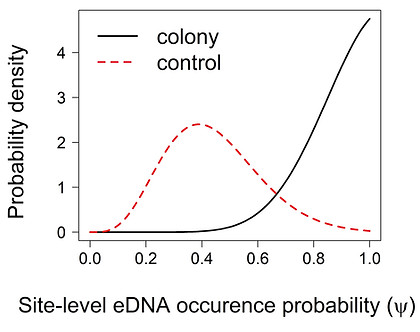Genotype-environment associations across an aridity gradient
For my dissertation, I have organized and led three months of fieldwork to sample the White-eared Honeyeater across an aridity gradient in New South Wales, Australia. Most of New South Wales is a highly fragmented landscape due to agricultural land-use change and White-eared Honeyeaters are now primarily only found in protected areas including national parks, state forests, and conservation areas. I have worked with dozens of Australians across multiple state and government agencies to obtain permits and site permissions to conduct this study. My research assesses the population genetic status of the White-eared Honeyeater across New South Wales and interrogates how neo-sex chromosomes and structural variants may facilitate local adaptation to aridity. With low coverage whole genome resequencing data, I am calculating population genetic parameters and conducting genotype-environment association analyses to determine which genomic regions and genes are involved in adaptation to aridity. My github repository for this project can be found here.
Evolution of neo-sex chromosomes in Australian honeyeaters
My dissertation more broadly focuses on neo-sex chromosomes in Australian honeyeaters. I feel a bit like an evolutionary detective delving into the origin and consequences of these unusual chromosomes. Besides describing the phylogenetic distribution and structure of these chromosomes, I seek to understand i) how neo-sex chromosomes facilitate local adaptation across environmental gradients, and ii) how gene expression in males and females is affected by the formation of neo-sex chromosomes.

Orzechowski, S. C. M., Doudin, D., Drew, A., Schmitt, C. J., Shams, F., Wilson, C., Joseph, L., Ezaz, T., and Edwards, S. V. (2025). Neo-sex chromosomes track the mitochondrial phylogeny and exhibit an extensive added stratum of recombination suppression in honeyeaters (Aves: Meliphagidae). In revision at Genome Biology and Evolution.
Burley*, J. T., Orzechowski*, S. C. M., Sin, S. Y. W., & Edwards, S. V. (2022). Whole-genome phylogeography of the blue-faced honeyeater (Entomyzon cyanotis) and discovery and characterization of a neo-Z chromosome. Molecular Ecology. https://doi.org/10.1111/mec.16604
*co-first authors
eDNA occupancy modeling to evaluate the threat of an invasive predator
Invasive Burmese pythons are negatively impacting multiple trophic levels in the Everglades and their cryptic coloration impedes detection and removal efforts. Dense wading bird breeding aggregations--colonies--represent an potential attractant for pythons, who have drastically reduced other prey bases like small mammals. Colonies and nests on tree islands isolated by water are vulnerable because pythons are semi-aquatic and use arboreal habitat.
For my Master's degree, I used environmental DNA to test the prediction that Burmese pythons are attracted to wading bird colonies of the Florida Everglades. Environmental DNA (eDNA) is a popular conservation tool for detecting rare or cryptic species when traditional survey methods fail. Pythons are remarkably cryptic and detection probability using visual surveys has been estimated to be less than 1%. Wading birds breed colonially in tree islands surrounded by aquatic marsh. I collected eDNA water samples at both colony and control islands during the wading bird breeding season. Then, I ran Bayesian hierarchical occupancy models to compare python eDNA occupancy rates. I found that python occupancy is higher at colonies during the breeding season, which is a cause for concern since I have also found that pythons are novel wading bird nest predators. My results underscore the need for a python management plan in wading bird colonies.


Fig 1. Estimated posterior distributions of python site occupancy (ψ) in colony versus control sites.
Orzechowski, S. C. M., Frederick, P. C., Dorazio, R. M., & Hunter, M. E. (2019). Environmental DNA sampling reveals high occupancy rates of invasive Burmese pythons at wading bird breeding aggregations in the central Everglades. PloS One, 14(4), e0213943.
Ecological impacts of an invasive apex predator
For my Master's degree, I also tested the prediction that Burmese pythons are directly impacting wading bird reproductive success through nest predation. Using trail cameras aimed at nests, I documented predation of both Great Egret and White Ibis nests by multiple pythons. Wading bird reproduction in the Everglades is generally limited by hydrology, not native predators, and therefore wading birds have been used as indicator species for the Comprehensive Everglades Restoration Program. As novel nest predators in wading bird colonies, pythons may be disrupting restoration predictions and consequent practices. My research indicates the need for future monitoring which will inform the potential need for python management action in colonies.

Orzechowski, S. C. M., Romagosa, C. M., & Frederick, P. C. (2019). Invasive Burmese pythons (Python bivittatus) are novel nest predators in wading bird colonies of the Florida Everglades. Biological Invasions, 21(7), 2333–2344.

Fig 1. Nest cams from my second year of monitoring in the central Everglades.
Effects of methylmercury on Great Egret populations
Methylmercury (meHg) contamination is prevalent in the Everglades and a bioaccumulative threat for piscivorous wading birds. MeHg can disrupt hormones, stunt nestling growth, and reduce reproductive success. Using Great Egrets as a model species, we investigated potential effects of meHg on Great Egret populations. We conducted non-lethal microsampling of albumen from developing eggs and took blood samples from nestlings to measure the impacts of methylmercury at different stages of the life cycle. We found that meHg concentrations in nestlings correlates with reproductive endpoints despite high environmental variability and reflects localized exposure of meHg in spatially disjunct colonies.

Zabala, J., Rodríguez-Jorquera, I., Trexler, J. C., Orzechowski, S., Garner, L., & Frederick, P. 2021. Accounting for food availability reveals contaminant-induced breeding impairment, food-modulated contaminant effects, and endpoint-specificity of exposure indicators in free ranging avian populations. The Science of the Total Environment, 791, 148322.
Zabala, J., I. Rodriguez-Jorquerra, S. C. M. Orzechowski, and P. C. Frederick. 2019. Non-lethal sampling on avian indicators reveals reliable geographic signatures despite highly dynamic patterns of mercury exposure in a large wetland. Environmental Pollution.
Zabala, J., I. Rodriguez-Jorquerra, S. C. M. Orzechowski, and P. C. Frederick. 2019. Mercury concentration in nestling feathers better predicts individual reproductive success than egg or nestling blood in a piscivorous bird. Environmental Science and Technology 53(3): 1150-1156.
Life history strategies in Tree Swallows and the effects of field methods on reproductive success
Tree Swallows serve as an excellent model system for examining reproductive trade-offs and life history strategies that shape fitness outcomes. As an undergraduate at Cornell, I participated in a long-term Tree Swallow study based in Ithaca, NY, first as a summer technician over two field seasons and then as crew lead and research support for a third season. I gained a strong foundation in avian field techniques, including banding, blood sampling, and measuring hundreds of chicks and adults.

I also had the opportunity to conduct research in multiple contexts, beginning with an undergraduate project where I used microsatellite markers to determine maternal kinship of nests with laying gaps. Tree swallows tend to lay one egg a day until they have completed their clutch, but laying gaps can occur during protracted cold snaps early in the breeding season. I was curious whether these laying gaps facilitated egg dumping from other females who might not have been able to secure their own nest box. This type of behavior is also known as intraspecific brood parasitism and has been observed in various avian species, including some swallows.
I am also interested in the effects of field methods on reproductive success, which is important to investigate, especially in long-term studies where birds are routinely sampled or tracked by investigators. Field methods can have unexpected or adverse effects on fitness if protocols are not implemented carefully and thoughtfully. I collaborated with other scientists in the Tree Swallow system to determine the potential effects of blood sampling on reproductive metrics and return rates of swallows.
Orzechowski, S. C. M., J. R. Shipley, T. M. Pegan, and D. W. Winkler. 2019. Negligible effects of blood sampling on reproductive performance and return rates of Tree Swallows. Journal of Field Ornithology 90(1): 21-38.







